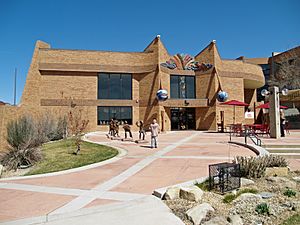Children's museum facts for kids

Children's museums are exciting places where kids can learn and have fun through special exhibits and programs. Unlike many traditional museums where you might only look at things, children's museums let you touch, play with, and explore everything! These museums are designed so that children can learn by doing. This idea suggests that being active and exploring can teach you a lot, especially when you are young. Most children's museums are non-profit organizations, which means they use their money to support their mission instead of making a profit. Many are run by volunteers or small teams of staff.
What Makes Children's Museums Special?
Children's museums focus on "hands-on" experiences. This means you get to interact directly with the exhibits. For example, you might build a giant structure, experiment with science, or create your own art. The main idea is that playing and exploring can be just as educational as being taught in a classroom. This type of learning, which happens outside of school, is often called "informal learning." It helps kids understand new ideas in a fun and engaging way.
Connecting Children's Museums Worldwide
There are special groups that help children's museums around the world connect and share ideas. One big group is the Association of Children's Museums (ACM). It started in 1962 and by 2007, it had 341 member museums in 23 different countries. Another group is The Hands On! Europe Association of Children's Museum (HO!E), which began in 1994. By 2007, it had members in 34 countries.
Many museums that are part of the ACM offer a cool benefit called "reciprocal memberships." This means if you have a membership at one of these museums, you might be able to visit other member museums for free or at a lower price! It's a great way to explore different museums as you travel.
Images for kids



